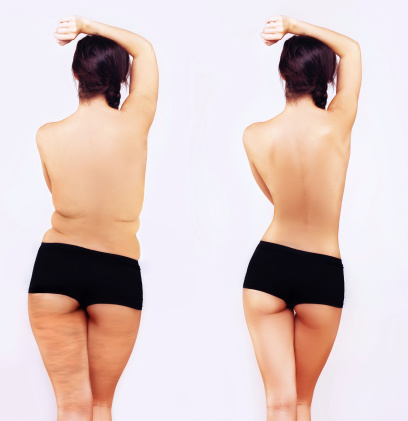
For decades, men and women alike have sought the liposuction procedure to solve their body contour problems. In spite of the tremendous popularity of this surgery, however, there are still many who believe liposuction is painful, dangerous, and risky.
In reality, the modern liposuction procedure carries a very low rate of complications. Thanks to improvements in technique, training, and technology, today’s liposuction is safer than it’s ever been for patients.
The Liposuction Procedure
If you’re having liposuction, you’ll likely receive a procedure using one of three techniques: the super-wet techniques, tumescent liposuction, and ultrasound-assisted liposuction. Both super-wet and tumescent liposuction involve a medical solution that is injected directly into the area where fat is to be removed.
This medical solution includes an anesthetic, epinephrine, and saline. Less fluid is in the super-wet technique than in the tumescent technique, so it takes less time. The ultrasound-assisted method is performed using ultrasound energy, which melts fatty deposits to make removal easier.
Regardless of the technique used to ease the removal of fat cells, your plastic surgeon will place tiny incisions around the treatment area. Through these incisions, a small cannula is inserted, then pushed back and forth to loosen the fat cells.
Using a surgical vacuum or syringe attached to the cannula, the loosened fat is sucked out and removed. By using either medical solutions or ultrasound energy, modern liposuction involves less maneuvering of the cannula, which results in less pain and bruising. These advanced medical techniques are making the procedure safer and easier already.
The Side Effects and Risks of Liposuction
Following the liposuction procedure, there are common side effects that every patient should expect. Swelling, bruising, and moderate discomfort are to be expected from the surgery itself. These are side effects common to almost all body contouring surgeries and have been greatly diminished in intensity and duration thanks to these new modern techniques.
Other risks after surgery may include post-surgical infection, delayed healing, blood clotting, fat clotting, shock, fluid retention, abrasions, perforations, lidocaine toxicity, and bad reactions to anesthesia or medication. Minor side effects can also include looseness of the skin, numbness of the treatment area, and slight changes in skin pigmentation. It’s essential to be aware of the risks you may personally face following any surgery, so be sure to consult with your plastic surgeon and openly discuss your medical history and any concerns you have. Once you understand both the risks and benefits involved with liposuction, you can make the right decision for yourself.
More Experienced Surgeons Make Liposuction Safer
The new techniques evolving around liposuction have already been discussed, but even these would be useless in the hands of inexperienced surgeons. Perhaps the most important way to safeguard yourself against potential risks is to carefully select a credentialed and experienced plastic surgeon. Better education on liposuction and other body contouring techniques is available from surgeons who have earned the credentials required to perform these surgeries. Improvements to education about liposuction can greatly decrease the risks posed to patients.
Additionally, liposuction is safer today because it is such a popularly chosen surgery. Ranking high on the list of most-requested surgeries, liposuction is a procedure surgeons have the chance to perform over and over again, developing their skills and honing their own techniques. They also gain the ability to examine and analyze a patient’s body in order to tailor the best liposuction surgery possible to their unique needs. These are skills that come from experience and can reap big benefits for a patient who chooses the right doctor.
The Anesthesia Choices for Liposuction
Originally, all liposuction surgeries were conducted under a general anesthetic, so that the patient was completely sedated throughout the procedure. At the time, these anesthetics would commonly lead to complications in patients who had allergic or otherwise bad reactions to the drug. As an essential part of the surgery, general anesthesia may have earned liposuction some of its reputation as a risky surgery.
Today, however, things are different. Not only are general anesthetics better and safer to use, but they aren’t even used for every liposuction procedure. Most often, a local anesthetic called lidocaine is used in conjunction with an IV sedation if needed. There is a much lower rate of reaction associated with lidocaine, which only numbs the targeted areas of the body. Even when patients do react to lidocaine, it’s often just a mild rash. While some situations do still require the use of general anesthetics, your risks are greatly lowered thanks to the advances in medical science. This change alleviates much of the danger once thought to be associated with liposuction.
Consultations and Liposuction Candidates
Part of the safer approach to liposuction today involves the one-on-one consultation process and how candidates are screened. A consultation is designed to both help you decide if liposuction is right for you and help your surgeon decide if you’re right for liposuction.
The surgeon will want to examine your body, learn about your medical history and lifestyle, and discuss your desired liposuction results. After all, if you’re a better fit for your surgery—any surgery—then that means you already know you’ve got a high chance of success and a low rate of complications.
Not everyone is a good candidate for liposuction surgery. You should be within 30 percent of your ideal weight, with specific areas to target for fat removal. If you are significantly overweight or obese, your surgeon may ask you to lose some of the extra weight before you are able to have the procedure performed, as this can reduce your risks and improve your results.
The best candidates are physically fit except for a few trouble spots, live a healthy lifestyle, don’t smoke, and have realistic goals about their body. Liposuction is not for patients with excess loose skin; other body procedures may be considered in that case. The best way to discover if you are a candidate for liposuction is to consult with an experienced plastic surgeon.
Reduce Your Risks With Dr. Kessler
Benefit from today’s modern liposuction techniques for a safer procedure that provides optimum results. Schedule your consultation with Dr. Robert Kessler, a board certified general and plastic surgeon, and find out if you’re a good candidate.
He completed his medical degree with honors from Tufts University in Boston and completed a distinguished General Surgical Residency with North Short/NYU in New York, before a Plastic Surgery residency with the US Air Force and the University of Texas.
Today, Dr. Kessler operates two practices in California, has worked as a surgical consultant and surgical assistant on ABC’s Extreme Makeover, and has lectured nationally and internationally on topics including facial rejuvenation, plastic surgery, and body contouring after substantial weight loss. To schedule an appointment with Dr. Kessler, contact his office, located at 2121 E Pacific Coast Hwy #200, in Newport Beach, California, by calling 949.644.6544.






